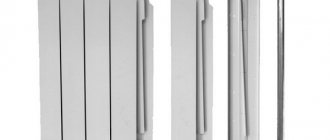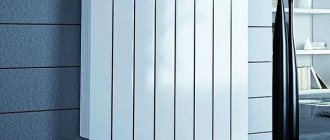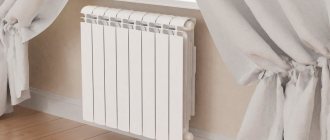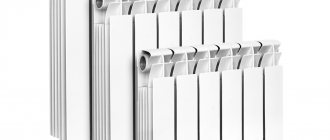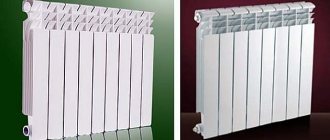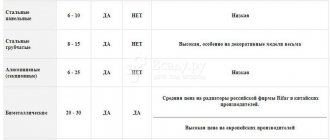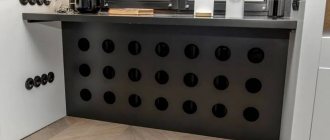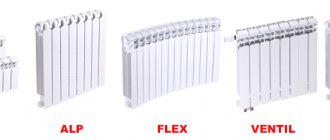Rating: 5,302
The warmth in the house during the cold period largely depends on properly selected heating equipment. For good and proper operation of the heating system, it is necessary to think through and calculate everything very carefully. Today you will learn how to choose the right bimetallic heating radiators for your apartment or private house.
It is necessary to take into account such nuances as the construction of the building and the climatic features of the region. Along with the heating systems offered on the modern market, bimetallic heating radiators deserve special attention.
How do bimetallic radiators work?
As already mentioned, bimetal batteries are based on two materials: steel and aluminum. The internal part of the structure (pipe), through which the coolant flows, is usually made of stainless steel (sometimes copper). This metal is very durable and does not respond to the negative influence of the aggressive environment of the heated coolant.
The outer side is made of aluminum and is a casing with fins. Aluminum has high thermal conductivity, warms up in the shortest possible time and the air in the room begins to warm up instantly.
Construction of bimetallic radiators
The inner and outer parts of each section are joined together by casting. This process is carried out under pressure or spot welding. Using steel nipples and heat-resistant gaskets that can withstand a maximum temperature of no more than 200°C, the sections are assembled into a battery.
The fact that the design of a bimetallic radiator contains parts made of steel is due to a number of positive characteristics that this metal has:
- steel can withstand pressure changes;
- steel is highly resistant to electrochemical influences, while internal surfaces made of aluminum quickly rust, and therefore their service life is short.
However, in turn, aluminum is characterized by high thermal inertness. On the one hand, this is an advantage, but on the other, it is a kind of disadvantage. Aluminum surfaces react very quickly to even minimal changes in temperature. Thanks to this property, you can very quickly adjust the temperature parameters of the heated room.
Due to the high heat transfer of aluminum, less coolant is consumed, while the amount of heat released is identical to that coming from cast iron radiators. That is why the dimensions of bimetallic heating radiators are more compact, and the shapes are very attractive in appearance.
Advantages and disadvantages
By purchasing an installation made of bimetal, your heating system will be provided with many positive aspects:
- First of all, it has a long service life. Thanks to the high quality of the design, which combines two good materials, such radiators can operate effectively for 30-50 years.
- Durability and reliability. These qualities are ensured thanks to the steel core, which is able to withstand high operating pressure and hydraulic shocks.
- Bimetallic heating radiators are suitable for any heating system, even with low-quality coolant.
- High heat transfer is another important positive quality. Due to the fact that the outer casing is made of aluminum, heat is distributed throughout the room very quickly. Standard models, in which the distance between the axes is 500 mm, have a heat transfer of up to 190 W, which is significantly more than in radiators made of only one metal.
- Thanks to the built-in thermostat, you can control and regulate the heating temperature.
- Externally, bimetal batteries are very attractive. Various color and design solutions allow everyone to choose a radiator to suit their taste.
As you can see, bimetallic radiators have a large number of advantages, which determine wide demand for such products. However, there are also some disadvantages that cannot be ignored when choosing:
- Different coefficients of expansion of steel and aluminum. In this regard, after long-term operation, noise and squeaks may occur in the heating circuit, and the strength of the structure will be lower.
- During the installation of radiators in a central heating system, heat-conducting pipes can quickly become clogged. This is due to the fact that they have a small diameter. Given this feature, it is better to be careful and install a coarse filter.
- High price of bimetallic radiators.
You can find out what material radiators are made from in this article.
Disadvantages and/or advantages?
It is recommended to equip bimetallic radiators with thermostats for quick heating.
Bimetallic radiators are usually blamed on the small cross-section of pipes,
because of which they can quickly become clogged with solid suspensions present in the water. However, you can cope with this problem (and also prevent premature failure of the unit) using a simple mechanical cleaning filter installed at the inlet. But if the radiator is equipped with a thermostat, then due to the same small diameter of the channels, temperature adjustment will occur in a matter of minutes.
Perhaps, the really “weak link” of combined instruments, paradoxically, is the very “duality” of their design. Due to the different thermal expansion of their constituent metals and the friction that arises between them, over time, radiators begin to make squeaks.
However, for high-quality products this should not lead to a decrease in strength and deterioration in heat transfer.
As for the high cost of bimetallic radiators compared to their aluminum, steel and cast iron “competitors,” the reliability, durability and efficiency of these devices will undoubtedly justify the costs incurred.
The smooth surfaces of bimetallic radiators and the absence of hard-to-reach cavities and “pockets” in their design make cleaning the devices convenient and easy
Types of bimetallic radiators
Radiators made of bimetal come in two types: monolithic and sectional.
Sectional ones are constructed from sections, each of which, inside horizontal pipe sections on both sides, has a multidirectional thread, through which connecting nipples with sealing gaskets are screwed in.
It is this design that is one of the most important shortcomings of bimetal batteries. The downside is that defects very often appear at the joints, for example, from low-quality coolant. As a result, the service life of radiators is reduced.
Also, in areas where sections are connected, leaks may occur under the influence of high temperatures. To avoid such unpleasant moments, another technology for the production of bimetallic heating radiators has been created. Its essence lies in the fact that initially a solid welded manifold is made of steel, then it is placed in a special mold and aluminum is poured on top of it under high pressure. Such radiators are called monolithic.
Both varieties have their advantages and disadvantages. We have already talked about the disadvantages of sectional ones, but their advantage is that if one section is damaged, then it is enough to just replace it. But if a breakdown or leak occurs in a monolithic structure, you will have to purchase a new radiator.
Let's conduct a comparative analysis of monolithic and sectional bimetallic radiators.
| Performance characteristics | Sectional bimetallic radiators | Monolithic bimetallic radiators |
| Service life, years | 25-30 | up to 50 |
| Working pressure, bar | 20-25 | up to 100 |
| Thermal power of one section, Watt | 100-200 | 100-200 |
The cost of a monolithic radiator is approximately 20% higher than a sectional one.
Kinds
Bimetallic radiators are available in two types:
- Cast. In this case, the battery case is cast in special molds;
- Sectional. This option is assembled from separate sections, which are joined together using a threaded connection.
The convenience of sectional models lies in the ability to add new sections as needed. It will not be possible to enlarge a monolithic battery in this way, but due to the wide range of radiator sizes, they can be selected for any task.
Both types of bimetallic heating radiators are used for heating installations in residential premises and administrative buildings. Which is better for an apartment depends primarily on the design of the heating network. For standard apartments in multi-storey buildings, it is better to use cast products, but in a country house, sectional ones can handle the load perfectly.
Bimetallic radiators can be produced in two versions:
- The steel tubes are filled with finned aluminum to form a single unit. This design is characterized by increased strength. The coolant in this case comes into contact exclusively with the internal surfaces of the steel tubes.
- The battery is assembled from separate sections in which steel tubes are installed in vertical channels. The sections are connected using threaded nipples.
The main disadvantage of bimetallic radiators is the small diameter of the tubes through which the coolant moves. Therefore, high-quality heating requires an increased flow rate of the coolant. And besides, if there are any impurities in the coolant, the tubes often become clogged, which leads to a drop in radiator power and a deterioration in the quality of heating in general.
Despite the fact that bimetallic radiators have a rather aesthetic appearance, they do not differ in the variety of design solutions. A significant disadvantage is the high cost of this type of battery with relatively low durability.
Selection of bimetallic heating radiators
When choosing bimetallic batteries, you should pay attention to a number of criteria on which the operating efficiency will depend.
More information about manufacturers of bimetallic radiators can be found here
Design
As already noted, radiators can be monolithic or sectional. In order to choose the most optimal option for a specific heating system, you need to know what the operating pressure is in the system. If it is exposed to powerful water hammer, then it is better to give preference to monolithic models. In all other cases, it is recommended to purchase sectional ones, since they are much cheaper.
To purchase a more reliable device, you should know that there are two types. The first type is made of a steel frame, the other is equipped only with steel-reinforced channels through which the coolant moves.
Batteries belonging to the first type are characterized by greater strength and reliability. In such designs, the coolant does not come into contact with the aluminum alloy, as a result of which the risk of corrosion is minimal.
The main features characterizing the first type are weight and cost. They are produced by the following companies: Royal Thermo BiLiner, Global Style, Rifar (Monolit model) and the domestic company Santekhprom BM.
Another type is called semi-bimetallic radiators. The main characteristics of such devices: high heat transfer and lower price. The most popular devices are Gordi, Sira and Rifar brands, excluding the Monolit model.
Center distance
Most manufactured models of bimetallic radiators are equally functional. However, the distance between the axles varies among models. Standard distances between axles: 35 and 50 cm.
You can find radiators in which the gap is 20 cm; this length is considered the minimum. Batteries with this distance are produced by the following companies: Sira, BiLUX and RIFAR. The maximum distance is 80 cm; such models are available from the manufacturer Sira.
Material of manufacture
It is important that the radiator withstands the effects of an aggressive environment well if the coolant is of insufficient quality and contains a large amount of alkali and acidity. This is mainly typical for batteries in apartment buildings.
Also:
- It is important that the internal channels are made of the same metal, preferably stainless steel.
- The wall thickness of the inner pipe should be 3-3.5 mm.
- The quality and elasticity of the gaskets plays a very important role. They are the ones that influence the reliability of the connections, so rubber or silicone is usually used as the manufacturing material for them. To check the quality of the O-ring, just bend it with your fingers. If the gasket is rigid and inelastic, then this indicates its low quality.
- If the radiator is sectional, then you should pay attention to the nipples. It is important that they are made of high quality steel. The low quality of these parts is evidenced by the softness of the metal. If it is of poor quality, then the hooks for the key will definitely break off and in this case the nipple will need to be sawed with a grinding machine and its parts removed from the holes of the sections.
- The width of the front part of the radiator fin should be more than 70 cm. If this figure is lower, this will affect the heat transfer of the radiator in a negative direction. The most optimal ratio of section size to cross-section is 80*80 mm. With such indicators, heat transfer will definitely be high.
- The thickness of the protruding ribs also indicates quality. This figure should be no lower than 1 mm.
Guarantee
The warranty period also speaks about the quality of the product. If the manufacturer gives a service life of only 1-2 years, this means that the likelihood that the radiators will work with high efficiency is small, because The operational period of a quality product is 20-30 years.
Review of popular brands and their prices
Buying bimetallic heating batteries is not a problem now, since their price in Moscow starts from 2,550 rubles (for a model with 8 sections).
Brief information about the most popular manufacturers:
- Italy . It produces Royal Thermo radiators, which are characterized not only by an attractive and non-standard design, but also by technical features. High-alloy steel is used for their manufacture. In the Thermo Beeliner model, the collector is made of stainless steel, which makes it almost eternal. From 570 rubles for one section;
- Germany . Oasis products are popular: they are sold inexpensively and have good characteristics. The product can easily withstand operating pressure up to 30 atmospheres;
- Ukraine . San Teh Rai company that produces Elegance batteries. Italian and Swiss equipment is used for production, and the models themselves are optimal for domestic heating systems. The cost of one section is 320 rubles, and the stated operating pressure is 30 atmospheres. Another Ukrainian brand is Altermo. Their radiators are designed for loads up to 18 bar, but are offered in different colors;
- Russia . Bilux company, whose production is located in China. These are technically high-quality products, with a 10-year warranty and a heat output of 182 W per section. Another Russian manufacturer is the Rifar company. Their products have a distinctive feature: they can withstand pressures of up to 100 atmospheres. Recently, products manufactured under the Lammin brand, priced from 1,650 rubles, have become popular;
- South Korea . Pioneer company, whose radiators have the following characteristics: coolant temperature no more than +130 ° C, pressure - up to 20 atmospheres. For the most part, these are classic models, available in the usual white color. From 1,820 rubles for 4 sections.
When choosing a manufacturer, first of all you need to take into account the technical characteristics. Not all models are suitable for domestic heating systems. Read our article about which stove is best to install in a bathhouse.
Specifications
The technical characteristics of batteries include dimensions. The height of radiators ranges from 20 to 80 cm. To select a radiator of the right size, you need to take into account the distance between the base of the window and the floor and subtract 20 cm from this number. The width is directly dependent on the location where the device will be installed.
Another important indicator is the working pressure, which varies between 15-35 atm. For centralized heating systems, it is better to choose the maximum values; for autonomous ones, the minimum values are also possible.
One of the most important and significant criteria affecting the efficiency of radiators is power. This indicator is determined based on the power of one section (it is indicated in the data sheet).
Calculation of sections of bimetallic heating radiators
In order to calculate the required number of sections based on the area of the room, you need to use the formula. To make the calculation, you need to know the following parameters: the power of one section and the area of the heated room.
In order to effectively heat 1 m² of area, you need 100 W of thermal energy. To calculate the area of a room, you need to multiply the width by the length.
Formula:
N= S*100/PN - number of radiator sections, S - room area, m², P - specific thermal power of one section.
Use the calculator to calculate the required number of sections of a bimetallic radiator.
Installation of heating radiators made of bimetal
Bimetal batteries must be installed in accordance with the instructions specified in the device passport.
In order to connect a radiator with your own hands, you need to take into account a number of factors:
- It is better to choose the middle of the window as a location for the battery;
- installation is carried out exclusively in a horizontal position;
- You need to maintain a distance of 3-5 cm from the wall to the battery. If you place the radiator too close to the wall, the result will be uneven distribution of heat;
- the distance to the window sill should be 8-12 cm, if it is less, it will negatively affect the heat transfer of the batteries;
- distance from the floor to the battery is 10 cm.
Installation of all system elements is carried out in a plastic radiator package. This packaging must not be removed until the entire installation process has been completed. The procedure for installing bimetallic heating radiators:
- Initially, you need to mark the proposed area on the wall where the brackets will be attached;
- then the brackets are fixed;
- batteries are installed on them;
- Next, the radiator must be connected to the pipes;
- then a thermostatic valve or faucet is installed;
- An air valve is installed at the top of the battery.
Everything about brackets for mounting radiators is written at the link
Installation features
The installation of bimetallic batteries is similar to the installation of steel and aluminum radiators, but it still has characteristic features. For example, before connecting hybrid devices, it is imperative to flush the communications, but it is prohibited to use alkaline solutions for this. When processing mating elements, you cannot use products containing abrasives - this can lead to depressurization of the system and the release of coolant.
Installation of bimetallic radiators is carried out as follows:
- mark the installation points of the brackets and fasten them to the wall;
- we hang the radiators on the fixed brackets so that the horizontal sections fit exactly on them;
- We connect the batteries to the heating system using taps and air valves that allow air to bleed.
Bimetallic radiator ROYAL THERMO BiLiner 500, 12 sections
A number of recommendations for the selection and operation of hybrid devices
In pursuit of the beauty of your interiors, do not cover the radiators with massive decorative screens; this will reduce the efficiency of these important elements of the heating system.
You can paint bimetallic radiators yourself, but not more than once a decade. Painting appliances dark increases their heat transfer.
When choosing heating devices and leaning towards buying bimetallic radiators, the technical characteristics and advantages of which have made them in demand and popular, weigh all the arguments for and against. Remember that when heating private houses and apartments with autonomous systems in which the pressure does not rise to critical levels, you can use less expensive batteries. But if the system uses poor quality coolant, bimetallic radiators will be the best option.
When installing hybrid appliances, strictly observe all standards and relevant SNIPs, and you will get rid of problems associated with heating systems for many years.
Manufacturers
Currently, on the heating equipment market you can find a large number of different models of bimetallic radiators produced by both Russian and foreign manufacturers. Let's look at the main characteristics of the most popular models.
| Model | Distance between axles, mm | Section size: width*height*depth (mm) | Maximum working pressure, Bar | Thermal power of the section, W |
| Rifar (Russia) | ||||
| Rifar Forza 350 | 350 | 415*90*80 | 20 | 136 |
| Rifar Forza 500 | 500 | 570*100*80 | 20 | 202 |
| Rifar MONOLIT 350 | 350 | 415*100*80 | 100 | 136 |
| Rifar MONOLIT 500 | 500 | 577*100*80 | 100 | 194 |
| Global Radiatori (Italy) | ||||
| Style 350 | 350 | 425*80*80 | 35 | 125 |
| Style 500 | 500 | 575*80*80 | 35 | 168 |
| Style Plus 350 | 350 | 425*80*95 | 35 | 140 |
| Style Plus 500 | 500 | 575*80*95 | 35 | 185 |
| Royal Thermo (Italy) | ||||
| BiLiner Inox 500 | 500 | 574*80*87 | 20 | 171 |
| BiLiner 500 | 500 | 574*80*87 | 20 | 171 |
| Tenrad (Germany) | ||||
| Tenrad 350 | 350 | 400*80*77 | 24 | 120 |
| Tenrad 500 | 500 | 550*80*77 | 24 | 161 |
| Gordi (China) | ||||
| Gordi 350 | 350 | 412*80*80 | 30 | 460 |
| Gordi 500 | 500 | 572*80*80 | 30 | 181 |
| Sira Industrie (Italy) | ||||
| Gladiator 200 | 200 | 275*80*80 | 30 | 90 |
| Gladiator 350 | 350 | 275*80*80 | 30 | 140 |
| Gladiator 500 | 500 | 423*80*80 | 30 | 185 |
| LLC Litiz (Ukraine) | ||||
| Altermo LRB | 500 | 575*82*80 | 18 | 169 |
| Altermo RIO 500 | 500 | 570*82*80 | 18 | 166 |
| Grandini (Italy) | ||||
| Grandini 350 | 350 | 430*80*82 | 16 | 130 |
| Grandini 500 | 500 | 580*80*80 | 16 | 167 |
Thus, high-quality bimetallic heating radiators are able to operate effectively for a long period of time.
